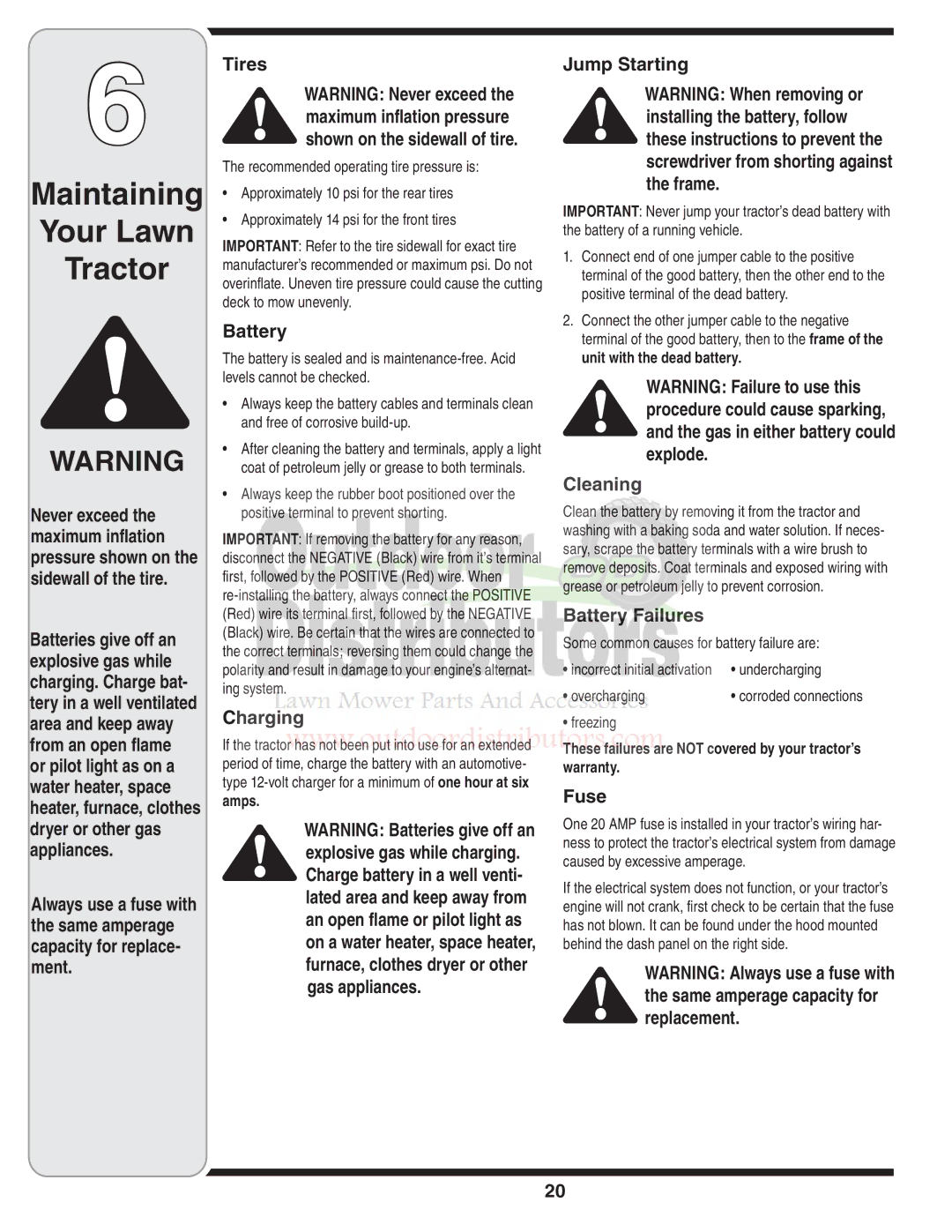
6
Maintaining
Your Lawn
Tractor
WARNING
Never exceed the maximum inflation pressure shown on the sidewall of the tire.
Batteries give off an explosive gas while charging. Charge bat- tery in a well ventilated area and keep away from an open flame or pilot light as on a water heater, space heater, furnace, clothes dryer or other gas appliances.
Always use a fuse with the same amperage capacity for replace- ment.
Tires
WARNING: Never exceed the maximum inflation pressure shown on the sidewall of tire.
The recommended operating tire pressure is:
•Approximately 10 psi for the rear tires
•Approximately 14 psi for the front tires
IMPORTANT: Refer to the tire sidewall for exact tire manufacturer’s recommended or maximum psi. Do not overinflate. Uneven tire pressure could cause the cutting deck to mow unevenly.
Battery
The battery is sealed and is
•Always keep the battery cables and terminals clean and free of corrosive
•After cleaning the battery and terminals, apply a light coat of petroleum jelly or grease to both terminals.
•Always keep the rubber boot positioned over the positive terminal to prevent shorting.
IMPORTANT: If removing the battery for any reason, disconnect the NEGATIVE (Black) wire from it’s terminal first, followed by the POSITIVE (Red) wire. When
Charging
If the tractor has not been put into use for an extended period of time, charge the battery with an automotive- type
WARNING: Batteries give off an explosive gas while charging. Charge battery in a well venti- lated area and keep away from an open flame or pilot light as on a water heater, space heater, furnace, clothes dryer or other gas appliances.
Jump Starting
WARNING: When removing or installing the battery, follow these instructions to prevent the screwdriver from shorting against the frame.
IMPORTANT: Never jump your tractor’s dead battery with the battery of a running vehicle.
1.Connect end of one jumper cable to the positive terminal of the good battery, then the other end to the positive terminal of the dead battery.
2.Connect the other jumper cable to the negative terminal of the good battery, then to the frame of the unit with the dead battery.
WARNING: Failure to use this procedure could cause sparking, and the gas in either battery could explode.
Cleaning
Clean the battery by removing it from the tractor and washing with a baking soda and water solution. If neces- sary, scrape the battery terminals with a wire brush to remove deposits. Coat terminals and exposed wiring with grease or petroleum jelly to prevent corrosion.
Battery Failures
Some common causes for battery failure are:
• incorrect initial activation | • undercharging |
• overcharging | • corroded connections |
• freezing |
|
These failures are NOT covered by your tractor’s warranty.
Fuse
One 20 AMP fuse is installed in your tractor’s wiring har- ness to protect the tractor’s electrical system from damage caused by excessive amperage.
If the electrical system does not function, or your tractor’s engine will not crank, first check to be certain that the fuse has not blown. It can be found under the hood mounted behind the dash panel on the right side.
WARNING: Always use a fuse with the same amperage capacity for replacement.
20
